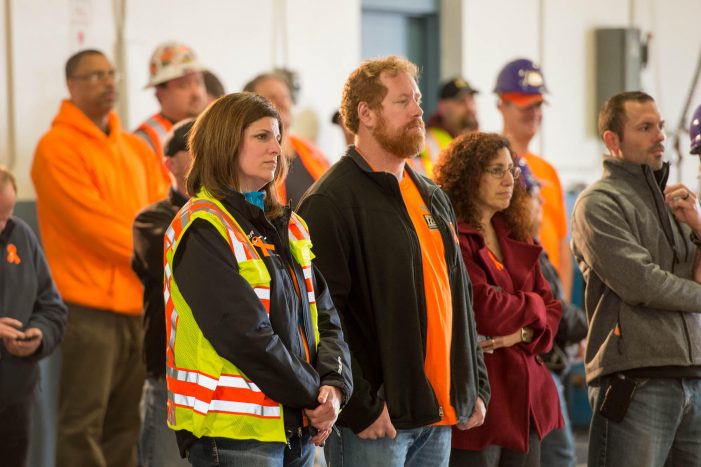Like most Americans, when Mike Heyboer goes to work each day, traffic conditions are on his mind. But it’s not simply a matter of weather conditions that worry him. It’s how we all drive in work zones.
Heyboer, a line worker with Give ‘Em A Break Safety, has heard all the horror stories – in fact, he’s seen them firsthand.

“You’re always watching your back, no matter what you’re doing,” he says.
Safety in work zones is a major issue. In 2014, driver and vehicle passengers accounted for 82 percent of work zone fatalities, according to a report provided by the U.S. Department of Transportation Federal Highway Administration. However, since 1999, work zone fatalities have fallen by 23 percent.
National Work Zone Awareness Week started in 1999 as a collaborative effort between the Federal Highway Administration, the American Traffic Safety Services Association and the American Association of State Highway and Transportation officials. Its goal is to “increase public awareness of work zone safety issues.” This year’s theme is “Don’t Be That Driver!”
The Michigan Department of Transportation (MDOT) recently held a kick-off event in the MDOT Brighton Garage, which featured officials from that department, the Michigan State Police, American Traffic Safety Services Association, Service Employees International Union, Consumers Energy, and the Michigan Infrastructure and Transportation Association.
National Work Zone Awareness Week ended on April 15, but the awareness shouldn’t end there, says Heyboer.

“I’d like to see people realize the guys working on the side of the road are real people with families,” he says. “They need to take it seriously when they’re driving through work zones to make sure that we all get home to our families.”
Heyboer witnessed the death of a co-worker due to a woman driving with a suspended license. She was driving down the shoulder at top speed and slammed into the work site. It wasn’t due to inclement weather or poor visibility conditions – it happened during the day.
Distracted driving is also a major concern for Heyboer and his colleagues, especially when it comes to cellphones.
“You see a lot of people while they’re driving, talking on their cellphones or looking down at their cellphones,” Heyboer says. “That for me is the scariest part, because it only takes a split second (for) you veer off to the shoulder a little bit (and) the worst happens.”

Charles Crews, vice president of gas operations for Consumers Energy, considers work zone safety a personal issue. Jeffery Creel, a journeyman line worker for Consumers Energy, was killed in 2012 by a careless driver.
“It was an awakening and awareness for us,” says Crews. “We have 1,800 employees. Not only are they my co-workers, they are people who I know or am good friends with. When I think about that orange barrel or the hard hat or the safety vest, (I know) that is the final protection for an employee.”
Crews urges drivers to stay focused. Don’t be that driver and pay attention when you’re driving this year.

For Brad Wieferich, deputy chief engineer and bureau of development director, MDOT, the memories are still very clear.
“I was out in traffic every day,” he says. “It becomes very much more real when you’re standing there having cars and semi trucks flying by you at a speed that you know is far over what is posted – it is dangerous.”
Wieferich wants people to understand how vital it is for drivers to pay attention to the signs, the speed limits and to their surroundings in order to minimize the potential for any injuries.
Another way to look at it, Wieferich says, is to see real people behind the statistics and those orange markers. That will certainly slow people down.
In his daily job in charge of the traffic services section for the Michigan State Police, First Lieutenant Jim Flegel has seen people balancing their checkbooks on the steering wheel while driving as well as doing their hair or makeup or shaving. And, worst yet, watching movies on their computers … all while driving.
It has to stop, he says.
Drivers should put their down their cellphones and pay close attention to what’s going on. It’s also essential to adhere to the speed limits in work zones. Generally speaking, if there are no workers present, the driver should not exceed 60 miles per hour. If workers are present, the speed limit is 45 miles per hour.
“Another thing we want to educate them on is to give the other drivers room and not to tailgate,” Flegel says. “Allow plenty of space in between cars so it gives drivers enough distance to make any maneuvers they need to make. There’s a variety of different things people can stop doing to make themselves and the construction workers safer in work zones.”



good post
Great post thanks for sharing….
Now almost, every people get shift from the SMS to Whatapps, which is due to unlimited massage, and allow sharing the photos to national to international. At the same, there are number of way that the children get misuse with closed one at the teen age.securtech
Drivers should put their down their cellphones and pay close attention to what’s going on. It’s also essential to adhere to the speed limits in work zones. Generally speaking, if there are no workers present, the driver should not exceed 60 miles per hour.
splendid group review